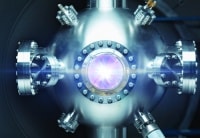Skunk Works, which works on advanced development programmes, says it is building on over 60 years of fusion research to develop an approach that offers a significant reduction in size compared to mainstream efforts. Furthermore, several patents are pending that covers its approach.
‘Our compact fusion concept combines several alternative magnetic confinement approaches, taking the best parts of each, and offers a 90 per cent size reduction over previous concepts,’ said Tom McGuire, compact fusion lead for the Skunk Works’ Revolutionary Technology Programs. ‘The smaller size will allow us to design, build and test the CFR in less than a year.’
After completing several of these design-build-test cycles, the team anticipates being able to produce a prototype in five years and will seek partners as the technology evolves.

Fusion reactions take place in the sun and are responsible for the energy it generates.
For a number of years, engineers and scientists have attempted to replicate this in order to create significant amounts of thermal energy from a relatively small amount of fuel that is made up of deuterium, which can be extracted from water, and tritium that is produced from lithium.
According to the Culham Centre for Fusion Energy, one kilogram of fusion fuel can provide the same amount of energy as 10 million kilograms of fossil fuel.
In the fusion process itself, a gas is heated up and separated into its ions and electrons. When the ions get hot enough, they can overcome their mutual repulsion and collide, fusing together and releasing energy that is around one million times more powerful than a chemical reaction and 3-4 times more powerful than a fission reaction.
Lockheed Martin says that to mimic the energy created by the sun and control it here on earth, it’s creating a concept that can be contained using a magnetic bottle.
It adds: ‘The bottle is able to handle extremely hot temperatures, reaching hundreds of millions of degrees. By containing this reaction, we can release it in a controlled fashion to create energy we can use.’
The heat energy created by the compact fusion reactor could have a myriad of uses, such as driving turbine generators by replacing the combustion chambers with simple heat exchangers. In turn, the turbines will then generate electricity or the propulsive power for a number of applications.
Two European projects are hoping to pave the way for commercially viable power generation using nuclear fusion – a breakthrough that could make a massive contribution to our energy and climate change worries. We put your questions to the scientists and engineers working on these ambitious and fascinating schemes. Click here to read more.











McMurtry Spéirling defies gravity using fan downforce
Ground effect fans were banned from competitive motorsport from the end of the 1978 season following the introduction of Gordon Murray's Brabham...